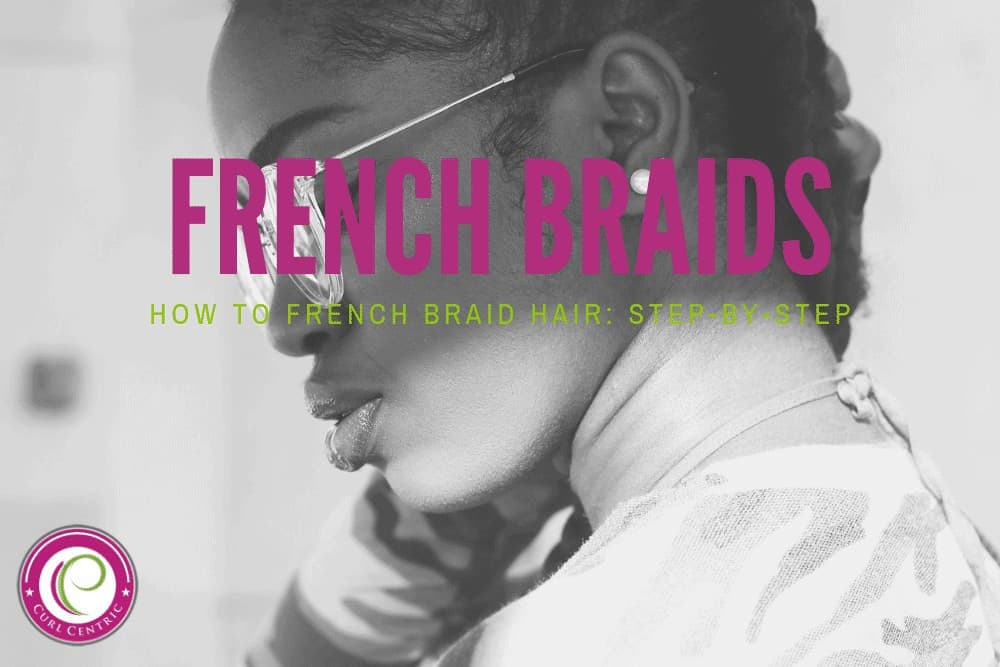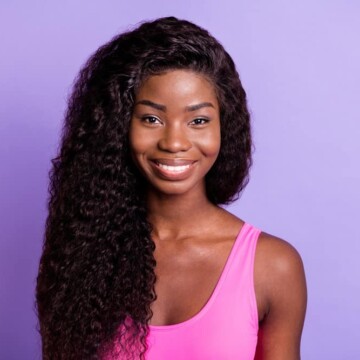
A French braid always looks classy and cute, and although it seems complicated, it’s pretty simple once you get the steps down.
This tutorial will show you how to french braid as well as which hair braiding tools will help you maintain the look, whether it’s for weekend shopping, a wedding or a night out on the town.
What Is French Braid?
A French braid is a type of braiding style that actually originated in North Africa before being adopted by the French.
The braid is also known as the tresse africaine, although it started being identified largely as a French braid around the 1870s.
Although the French braid is regularly attributed to North Africa (and rightfully so), especially Algeria, there are also early depictions of similar hairstyles in Greek and Celtic history, as well as imperial China.
The traditional French braid isn’t only pretty, but it incorporates all of your hair, easing the strain on your hair strands and causing less breakage than a traditional braid.
Throughout the years, variations on the French braid have emerged, such as the Dutch braid and the Fishtail braid.
A Dutch braid involves a nearly identical process as a French braid, except you cross the sections of hair under each other instead of over each other.
The result is an “inside-out” braid that has more dimension and thickness. A Fishtail braid involves crossing two strands of hair instead of three.
Table of Contents
Step-by-Step Guide to French Braiding
Below are some simple steps to creating a basic French braid. Start with this tutorial and as you get more comfortable with the process, you can try out other variations on the French braid.
You can try starting from the side of your head, creating French braid pigtails, or even trying a Dutch braid. The styling options are only limited by your imagination.
1. How to Prep Your Hair for French Braiding
We always recommend starting with clean hair (i.e., freshly washed hair). Although depending on your hair type, how often you need to wash your hair could vary.
Our research indicates that straight hair needs to be washed more often than other hair types since straight hair tends to more oily than wavy, curly or kinky hair types.
Start by using a wide-tooth comb or a hair brush designed for curly hair to detangle your hair and remove any kinks.
This will make your hair easier to work with as you start french braiding.
If you want a single braid down the back of your head, brush your hair back so there is no part. You can following the tutorial above by Lisette.
If you want a French braid on either side of your head, part your hair down the middle and follow Lisette's video tutorial below.
2. Prepare Sections of Hair
Getting a great French braid starts with sectioning the hair off correctly. Start at the top of your head and section off a portion of hair, about three to four inches wide.
Make sure that all of the hair that you gather in this section is coming from the top of your head. You don’t want strands coming from the sides at this point, as this will mess up the look and structural integrity of your French braid.
When you have that initial section of hair, you need to divide it into three subsections.
Just as when you are doing a regular braid, the three sections of hair should be as close to the same size as possible. Use your fingers to divide the sections and smooth them out.
3. Begin the Regular Braid
A French braid actually starts out as a regular braid. Therefore, you want to start as you normally would when braiding hair.
Keep in mind that it’s important to get your hand positions down so that you don’t get confused while continuing the braid. We recommend holding two strands of hair in your right hand and the third strand of hair in your left hand.
Try to always keep two sections in your right hand and one in your left hand, so you have an easier time completing the French braid.
It also helps to think of the sections in terms of their position: right, center, and left. Essentially, as you complete the braid, you are repeating a pattern.
You cross the “right” section over the “center” section and then cross the “left” section over the “center” section in the opposite direction.
Getting this right-to-left and left-to-right crossing pattern down can take some time, so don’t get frustrated if it takes you a few tries to get it right.
4. Begin Adding New Sections of Hair
You should start with the initial braid, which should include crossing the one strand of hair over the other about three or four times.
At this point, it is time to start adding new sections of hair to get that French braid look. Remember that you are crossing the right-most section over the center section, then crossing the left-most section over the new center section.
Now, each time that you cross a strand of hair over, add a bit more hair to the section. You can pull this hair from the outer part of your hair, near your face.
Otherwise, your braid will get covered up as you add more hair further down the braid. It doesn’t really matter how much hair you add to each section as you cross it over.
Just focus on taking it from the outside sections so that you get a complete-looking braid. Smaller sections of hair will result in a tighter, more intricate braid.
5. Repeat the Process, Using All of Your Hair
Next, you just need to keep repeating this cross-over pattern. You should end up using all of your hair, and you will notice that you run out of sections of hair to incorporate into the braid as you work your way down.
Depending on the length of your hair, this process could take a bit of patience but hang in there. It will be worth it in the end.
Once you have added all of the hair from the sides of your face, you won’t have any more hair to add for a French braid.
At this point, you can continue the braid as a traditional braid. When you reach the end of your hair, secure the braid with a hair tie. You’re all set!
Optional: Try Different Styles and Variations
The standard French braid is just one of the ways that you can work with this braiding style.
Once you get the hang of it and can easily do the single French braid down the back of your head, why not try spicing things up a bit?
For instance, you might do French braids down the side of your head, looping it around for an elegant braid. You can also section off different parts of your hair to create multiple French braids.
If you want to try reversing the braiding process, you can end up with a lovely Dutch braid. It involves crossing the strands of hair under each other instead of over each other like in a French braid.
If you work with two strands of hair, you can create a fishtail. Incorporating ribbons into the braid will give you a delicate look, perfect for a summer wedding or just a fun weekend hairstyle.
Remember to have fun and don’t put too much pressure on yourself to get the French braid right on the first try. Just like when you learned to tie your shoes, it took time, practice, and patience. You’ll get there!
Best French Braid Hair Tools
If you’re a newbie, struggling to learn how to french braid or you simply don’t want to take the time to learn how to create intricate braids, then there are braiding tools that will make things easier.
These braiding tools can make it look like you know how to French braid even if you haven’t taken the time to learn.
French Braid Tool Topsy Tail Loop Hair Kit
For a multipurpose tool that will help you create a French braid, flip ponytails, and more, try the Topsy Tail Hair Tool. It works on many different hair types and textures and can help you achieve that elegant braided look without all of the effort.
There are different ways to use the tool on your hair so that it can help with sectioning off strands, pulling sections out, crossing them over, and adding more dimension to your hair.
DIY Braiding Hair Sponge
This braiding hair sponge is meant to give you a template to follow while braiding your hair, helping you create braided sections of hair that are equal size and width.
It can help you get a cleaner-looking braid, especially if you aren’t confident in your own French-braiding abilities. To use it, part your hair and place the initial section in the braiding hair sponge.
Use the grooves to portion out your strands of hair and then work your way down your hair, braiding as you go along and using the braiding sponge as a template.
Magic Hair Braiding Set
Another popular tool is the Magic Hair Braiding Set, which is a flexible, wavy tool that can sit in your hair to keep your braids uniform and neat.
Place it at the crown of your head and use it as a template for completing your French braid.
Your hair will cover the tool so that it stays in your hair when the braid is complete. It is invisible to others since your hair is covering it up.
This tool makes it easy to keep the structural integrity of your braid and show off a beautiful hairstyle with minimal effort.
Lightweight Detangler
You will also need a good detangler before you start French braiding your hair. Garnier’s Whole Blends 5-in-1 Lightweight Detangler Spray is a good choice.
This paraben-free formula contains green apple and green tea extracts to add strength and moisture to your hair while naturally detangling it and giving it added shine.
It is perfect for spraying onto hair as you prep it for a French braid.
Finally, you need hair ties that won’t cause breakage, these rubber hair ties usually work pretty well.
They have a protective outer layer, so your hair won’t get tangled up in the rubber, plus there aren’t any metal parts that could damage your strands.
Frequently Asked Questions
Do you still have questions about creating French braids? Here are the answers to some frequently asked questions that might clear things up for you.
Are French braids good for formal occasions?
Yes! A French braid can be styled for a casual outing with friends or for a more formal event, such as a wedding.
Once you learn different variations of the French braid, you can play around even more with fancier styles. In addition, you can add hair accessories to the braid to complete the look.
Can a French braid work on thick or curly hair?
Absolutely. French braids work on just about any kind of hair, even certain shorter lengths, and all straight, wavy, curly or kinky textures. The only inhibitor would be the length of your hair, although you could always use weave or extensions to add additional length.
Can I French braid hair with bangs?
Yes, and it is up to you whether you want to incorporate the bangs into the braid or not. Either option is just fine and will give you a slightly different look.
Can I French braid wet hair?
Yes, and this will often result in a wavy texture when you end up taking the French braid out. That being said, wet hair can be a bit tricky to work with since it can be more prone to tangling depending on your texture. Depending on your hair texture and thickness, wet hair could easily slip out of your fingers while you’re trying to braid.
What if my hair has layers? Can I still French braid?
Yes, but just be aware that the braid may end up looking a bit different since hair might stick out of the braid at odd angles. In this case, it can help to have some bobby pins or hair spray on hand to keep those flyaways from ruining the look of the braid.




